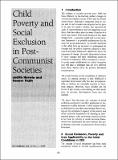| dc.contributor.author | Harwin, Judith | en |
| dc.contributor.author | Fajth, Gaspar | en |
| dc.date.accessioned | 2016-02-24T15:14:09Z | |
| dc.date.available | 2016-02-24T15:14:09Z | |
| dc.date.issued | 01/01/1998 | en |
| dc.identifier.citation | Harwin, J. and Fajth, G. (1998) Child Poverty and Social Exclusion in Post?Communist Societies. IDS Bulletin 29(1): 66-76 | en |
| dc.identifier.issn | 1759-5436 | en |
| dc.identifier.uri | https://opendocs.ids.ac.uk/opendocs/handle/20.500.12413/9178 | |
| dc.description.abstract | Summary Poverty has increased with the shift to the market economy in Central and Eastern Europe and the former Soviet Union, and families with children have been particularly exposed to social deprivation. However, a poverty approach alone cannot explain the higher risks for child well?being across the region. When the outcomes are measured by social cohesion factors, they are found to be worse in several countries with less acute poverty increases than in those affected most severely. This article therefore suggests that a social exclusion framework would better capture the process of transformation, the multi?dimensional nature of the changes and their underlying causes in countries in transition. The replacement of a poverty relief approach with a social integration effort, however, suggests that a different strategy should be adopted to tackle the social decay which is having a particularly negative effect on children in countries in transition. | en |
| dc.format.extent | 11 | en |
| dc.publisher | Institute of Development Studies | en |
| dc.relation.ispartofseries | IDS Bulletin Vol. 29 Nos. 1 | en |
| dc.rights.uri | http://www.ids.ac.uk/files/dmfile/IDSOpenDocsStandardTermsOfUse.pdf | en |
| dc.title | Child Poverty and Social Exclusion in Post?Communist Societies | en |
| dc.type | Article | en |
| dc.rights.holder | © 1998 Institue of Development Studies | en |
| dc.identifier.doi | 10.1111/j.1759-5436.1998.mp29001008.x | en |

